Heiliggeist-Hospital (today: retirement home)
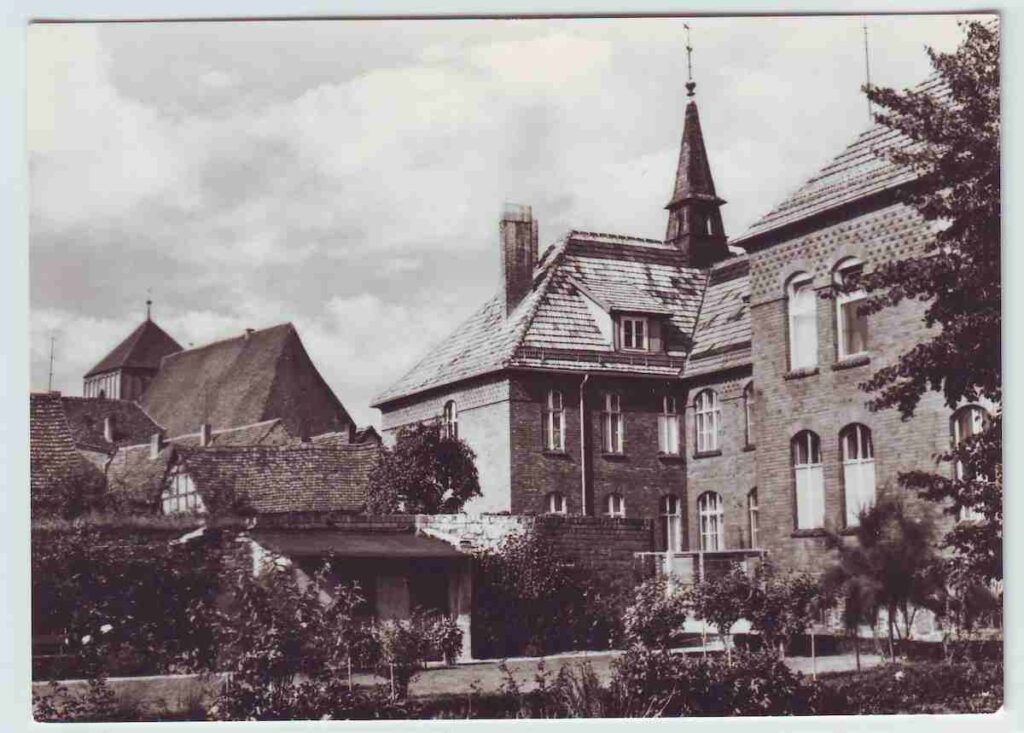
Nursing home 1970s, with the rest of the city wall, postcard archive Wegemuseum
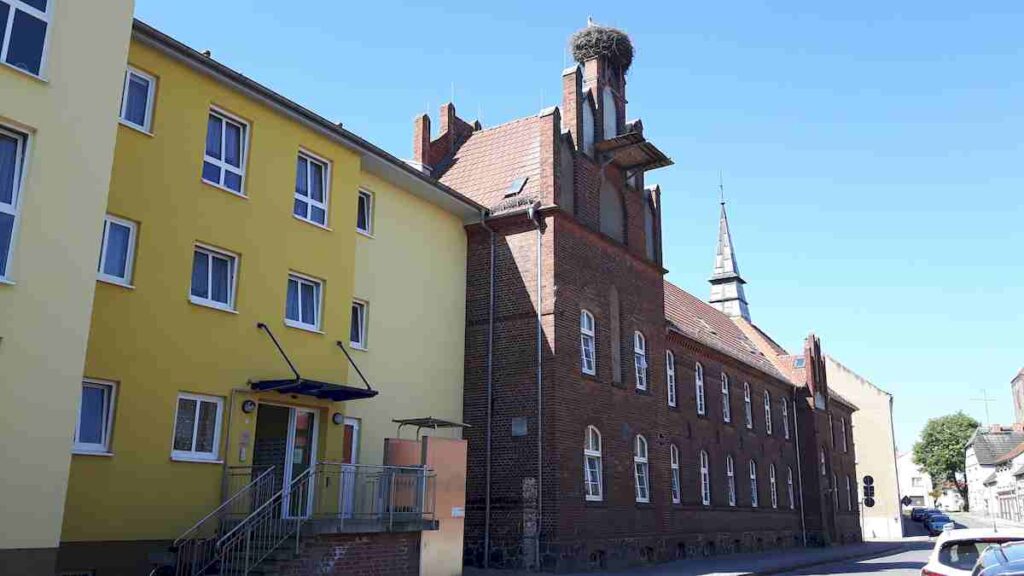
Retirement and nursing home on the former site of the Heiliggeist Hospital, photo: KAZ
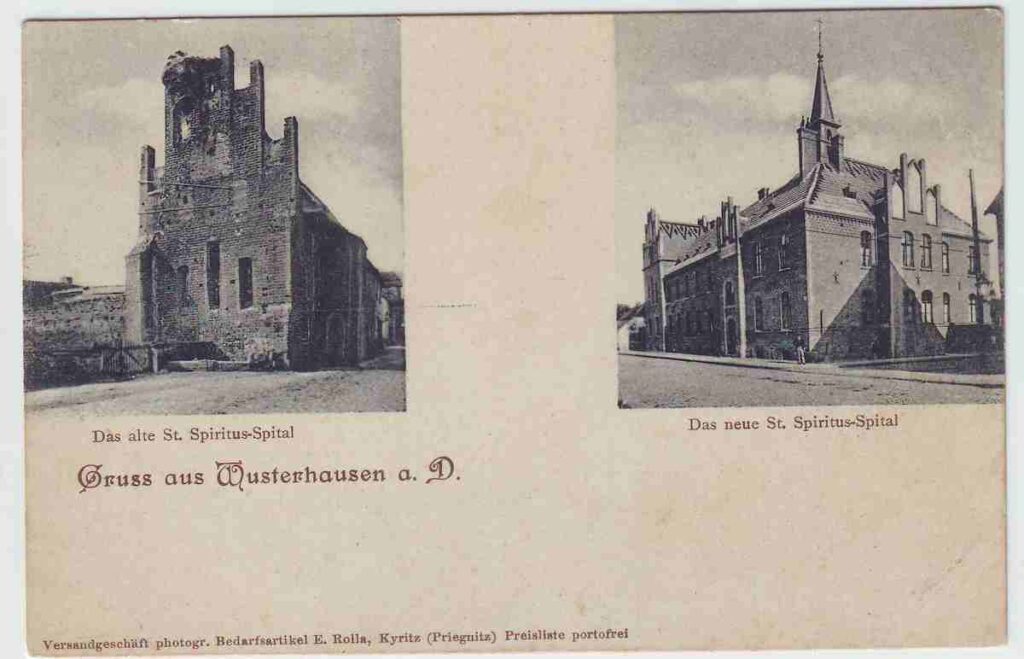
Heiliggeist-Hospital old and new, postcard after 1897, Wegmuseum archive
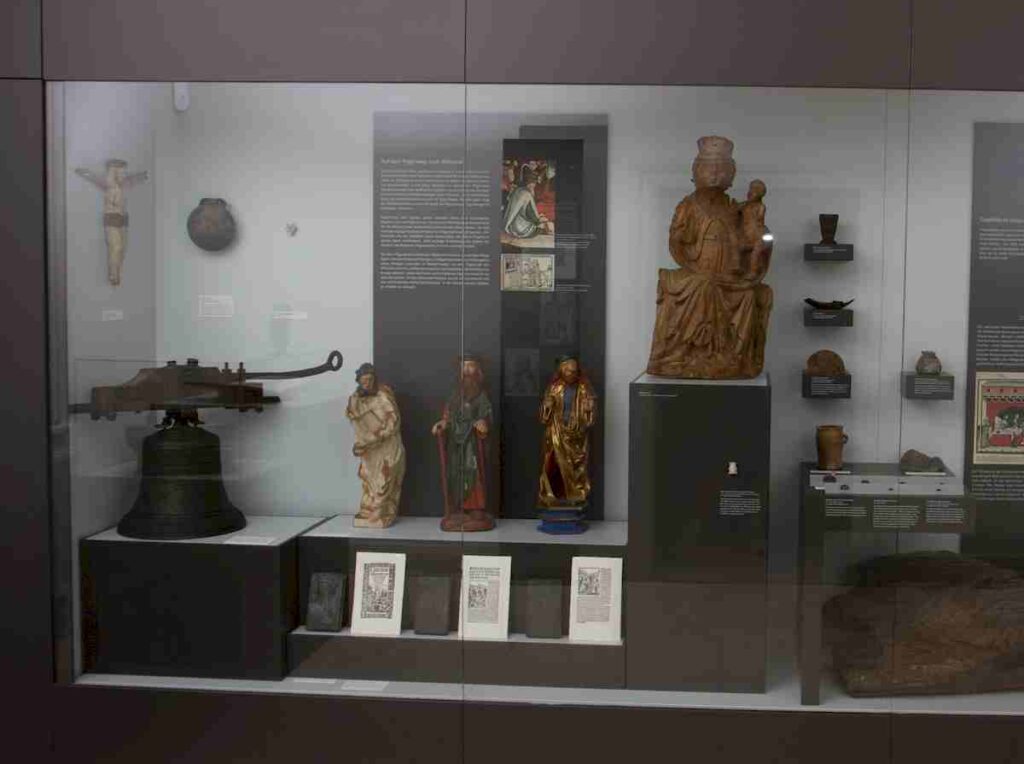
Far left: poor sinners' bell from the Heiliggeist-Hospital - exhibited in the Medieval room of the Wegmuseum, photo: KAZ
The Gothic hospital and its successors
The previous building was the Heilig-Geist-Hospital (or St. Spiritus-Hospital), already mentioned in 1307. It was demolished in 1896 and replaced by a new building with a stepped gable based on the old Heilig-Geist-Hospital. The new building in 1897 was financed with an amount of 105,000 gold marks, which Borchert, who was born in Wusterhausen in 1815 and owns the Berlin brass works, bequeathed to the city in his will for the benefit of the hospital. Therefore, Wildberger Straße was renamed Borchertstraße. A foundation ran the hospital, from 1954 it was a state-run after-work home, later a nursing home, today the nursing home of Pro Seniorenpflege. The new building complex was built in 1997 and the old building has been modernized since then.
The medieval building stood further into the street and was connected to the Wildberg town gate. The gable did not face the street, as it does today, but east towards the city wall and was possibly part of the city wall. A remnant of the city wall with a fortified tower has been preserved in the courtyard of today's nursing home.
The hospital was perhaps a beguinage, women lived here in close unions. The desire for religiosity and charitable commitment were in the foreground. However, there is no written source for this. Chronicler Altrichter only says "possibly", although the beguines were widespread in the region.
Visitation report 1544: The city poorhouse was also attached to the hospital. The chapel was no longer used after the Reformation and was converted into a residential building.
Chronicler Karl Altrichter drew the Gothic murals before the building was demolished.
Theodor Fontane also reported on the hospital in his "Wanderungen durch die Mark Brandenburg" in 1873. Remarkable: The stork's nest can already be seen in the photos of the old building.
There were two hospitals in the Middle Ages that no longer exist today (locations unknown): St. Gertrud in front of the Kyritzer Tor - pilgrim's hospital, and St. Georg (Wanderer, nursing), which was merged with the Heiliggeist-Hospital after 1544, location possibly before the Wildberger Tor – St. Georg-Strasse as a street name is reminiscent of the St. Georg Hospital.
Text: Dirk Schumann:
The former Holy Spirit Chapel and the medieval hospitals of the city of Wusterhausen
The Heilig-Geist-Hospital was still within the city wall but directly at the former gate on the road leading east from the Mark towards Neuruppin, today Borchertstraße.
A location of the hospital in the immediate vicinity of a city gate is not so unusual. The Heilig-Geist-Hospitals were also in Prenzlau and Berlin in such a place. Today there is a nursing home in Wusterhausen on the site of the hospital, whose neo-Gothic gable facing the street is vaguely reminiscent of the medieval Holy Spirit Chapel. And it was definitely intentional, because the medieval chapel was demolished in 1896 on condition that the chapel gable be rebuilt using the building material that was still usable using a similar technique. In Wusterhausen, the edition was used relatively freely, because the gable was turned to face the street and it was completed with nine stones. Only the stork's nest, already enthroned on the medieval gable, still exists today. The trigger for the new building was the noble foundation of Christof Borchert, who was born in Wusterhausen, for the Heilig-Geist-Spital. Borchert - after whom the former Wildenberger Straße is named today - had become rich in Berlin and was the owner of the brass works there. He donated more than 100,000 gold marks, which triggered a high level of investment pressure.
It was not until ten years later that the medieval Heilig-Geist-Kapelle (Holy Spirit Chapel) was prevented from being demolished in Berlin and that it was included in the new building of the commercial school there.
Fontane, who in 1861 published the volume on the county of Ruppin, his wanderings through the Mark Brandenburg, saw the Wusterhausen hospital chapel in the original. However, his verdict was not very lenient:
“The building presents itself on its two fronts as a miserable construction from the last century; just a little further towards the suburbs, ... there is still a Gothic gable, quite picturesque, with a bell niche and a stork's nest. It is only after you have passed through one of the front houses, no matter which one, that you realize that you are in a monastic complex: a courtyard surrounded by houses on three sides; the fourth side, ending the square, a chapel.
Like the three houses, the chapel is also inhabited, and has long ceased to be used for church functions. Altars have become hearths, and instead of incense peat smoke fills the air; Split wood is piled high in the niches, and where a carved image of Christ used to hang between the pillars, there is now a loft on which boxes and chests, forefathers’ household goods, and the last offshoots of old junk stand.”
Unlike the Hospital St. Gertrud, which was dissolved during the Reformation, and the Hospital St. Georg, which later disappeared, the Heilig-Geist-Hospital continued to exist as an institution. It was not only - like other Heilig-Geist-Hospitals - the most distinguished municipal hospital foundation, but also the oldest. Because as early as 1307, the council confirmed the foundation of the noble Werner von Plänitz, who gave the inmates eternal alms to buy beer. Two things can be inferred from this. On the one hand, in the Middle Ages it was assumed that a foundation would last forever. In this way, one donated sufficient capital or real estate from the interest or from the income of which one regularly carried out a benefit such as the purchase of beer. In the Middle Ages, for example, it was not expected that money would lose value, which repeatedly led to precarious conditions in the late Middle Ages. On the other hand, the document makes it clear that the hospital had a permanent base of inmates who lived here and were cared for until the end of their lives.
Hospitals were the first charitable institutions dedicated to caring for the poor or travelers. They took care of food, clothing or even taking in the needy and caring for the sick. A very important aspect was the appropriate burial of the dead who could not afford a burial. In the course of the late Middle Ages, the hospitals developed more and more into institutions with a permanent base of needy inmates. Soon, just like today, one could buy oneself into such an institution to provide for one's old age. However, the inmates lived together according to fixed rules like communities similar to a monastery, which also included a service in the hospital chapel several times a day. As in a monastery, 12 inmates were gladly accepted in succession to the 12 apostles or, depending on their wealth and equipment, a multiple of this number. The hospitals were mainly maintained by the foundations of wealthy citizens, who often also supervised these institutions. After the Reformation, the remaining hospitals developed more and more into retirement homes. And so this facility in Wusterhausen is still a retirement home today, which was expanded in 1997 with another new building
In Wusterhausen, the medieval chapel building, known from descriptions, from Friedrich Adler's floor plans, from various historical photos and not least from recent archaeological excavations, was a rectangular hall building built in two sections with a flat ceiling, which even had late Gothic paintings. According to the drawings made by the local chronicler Karl Altrichter before the demolition, these are scenes from the Passion of Christ with many figures, which, according to the recognizable stylistic details, belong to the early 16th century.
The hospital chapel was first built in the 13th century with some respect to the city wall. Although it was suspected otherwise several times, this assumption of the first explorer of Brandenburg brick architecture - Friederich Adler - is plausible. The extension to the east in the course of the 15th century was probably due to the increase in the number of inmates. On the other hand, the extension only became possible at all when, from the late 14th century, the gate systems of Mark's city fortifications were enriched with fences, outer gates and additional ditches. This development can also be assumed for Wusterhausen, which means that the area directly at the gate was now better secured and was available for inner-city development. As Fontane also reported, the inmates' houses, which surrounded a rectangular courtyard on three sides, also belong to the hospital.
In the Middle Ages there were two other hospitals, the location of which is not even known today. According to 16th-century tradition, they were outside the city walls. According to custom, they may have been located on important medieval roads. With regard to the Heilig-Geist-Spital and the St. Stefan chapel, these two facilities are likely to have been located on the roads to Kyritz and Havelberg. In accordance with a division of responsibilities, these hospitals provide more care for the travelers and the sick. It is said that the St. Gertrud Hospital was open to pilgrims traveling to Wilsnack. Perhaps for this reason it was closed in the course of the Reformation in 1541 and its income added to the Georgs-Hospital, which was primarily dedicated to taking in the sick and lepers.
Additional information
Exhibition: The small bell is called the poor sinner's bell, it belonged to the former Holy Spirit Hospital and rang when someone was executed in Wusterhausen.
Bell, 1583, bronze, origin: Heilig-Geist-Kapelle, Wusterhausen
The bell, made by a foundryman from Wittstock, bears the inscription:
WER GODT VORTRVET VAST VPEMBUET DEMWERTESNICH GERVEN (Whoever trusts God, builds firmly on him, will not regret it.)
The bell comes from the Heilig-Geist-Hospital, which was demolished in 1896, where the sick were cared for and pilgrims could stay overnight.
See also: Stages of the executioner tour
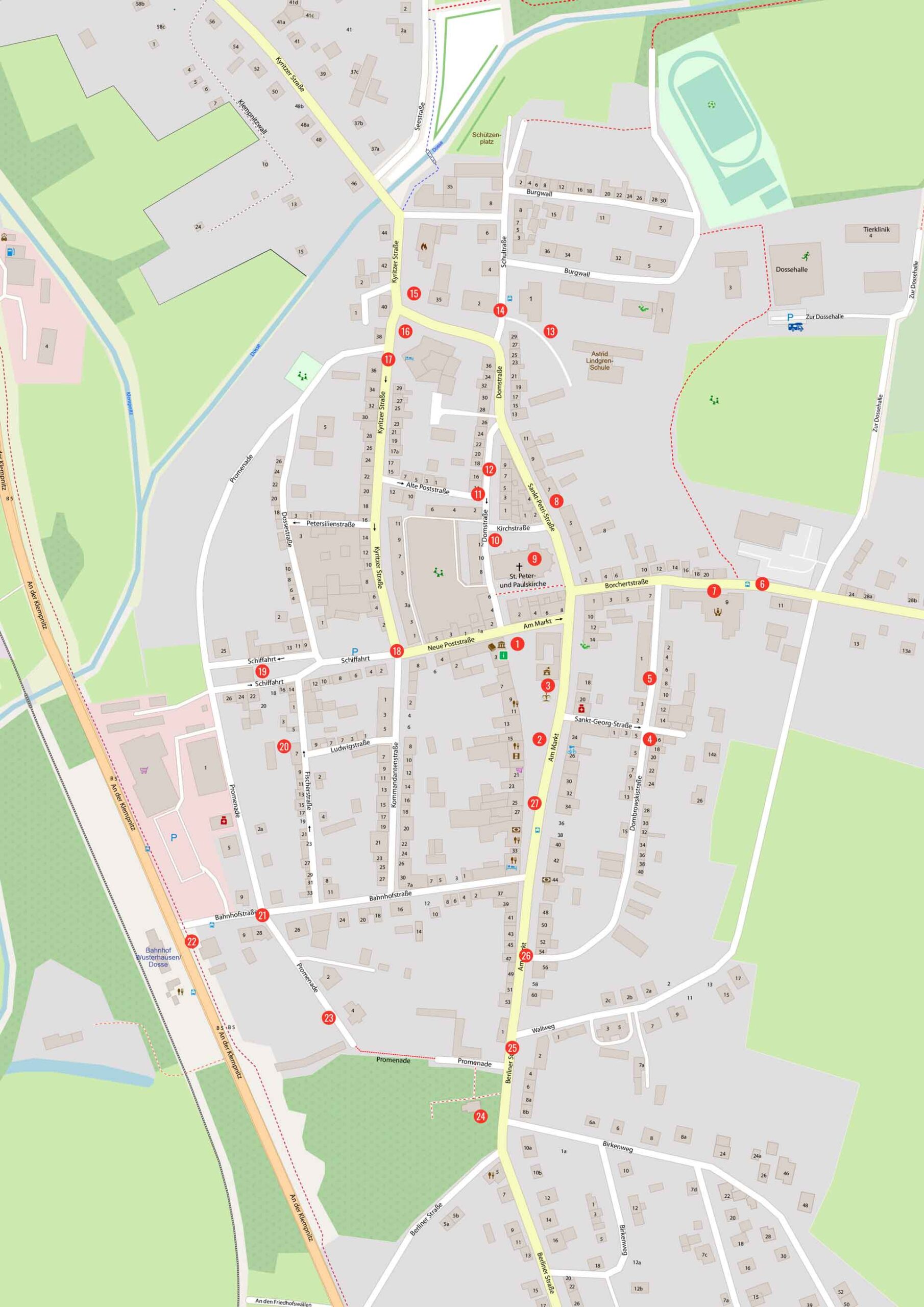
City walk map general view
